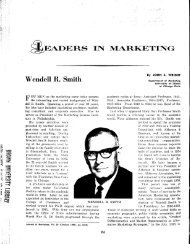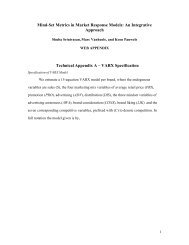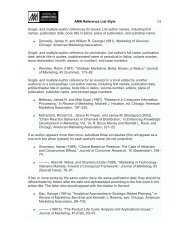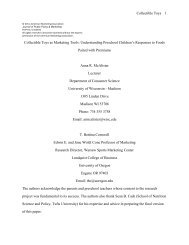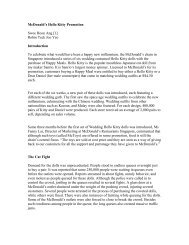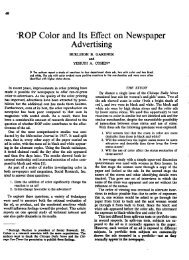Automated Marketing Research Using Online Customer Reviews
Automated Marketing Research Using Online Customer Reviews
Automated Marketing Research Using Online Customer Reviews
Create successful ePaper yourself
Turn your PDF publications into a flip-book with our unique Google optimized e-Paper software.
[6] Constrained Logic Programming<br />
To align words into their corresponding attribute dimensions, we frame the task as a<br />
mathematical assignment problem and resolve the problem using a bounds consistency approach. We<br />
define the assignment using the maximal clique that corresponds to the schema for each product attribute<br />
table (see Figure WA1.1). In the bounds consistency approach, we invert the constraints (tok_exclusion)<br />
to express the complementary set of candidate assignments (tok_candidates) for each attribute dimension.<br />
If the phrase constraints, taken together, are internally consistent, then the candidate assignments<br />
(tok_assign)for a given token are simply the intersection of all candidate assignments as defined by all<br />
phrases in the cluster containing that token.<br />
We transform the mutual exclusivity constraint represented by each phrase into a set of candidate<br />
assignments using the algorithm in Figure WA1.2. Note that we need only propagate the mutual<br />
exclusivity of words that are previously unassigned. Accordingly, for each unassigned token in a given<br />
phrase, the set of candidate assignments is the intersection of the possible assignments based upon the<br />
current phrase and all candidate assignments from earlier phrases containing the same token. We<br />
maintain a list of active tokens boundary_list to avoid rescanning the set of all tokens every time the<br />
possible assignments for a given token is updated.<br />
Finally, the K-means clustering used to separate review phrases into distinct product attributes is<br />
a noisy process. The clustering can easily result in the inclusion of spurious phrases. Both the initial<br />
process_phrases(p_list)<br />
[1] schema = find_maximal_clique(p_list)<br />
[2] order phrases by length<br />
[3] for each phrase p:<br />
[4] # initialize data structures<br />
[5] tok_exclusion – for each tok, mutually exclusive tokens<br />
[6] tok_candidates – for each tok, valid candidate assignments<br />
[7] tok_assign – for each tok, the dimension assignment<br />
[8] # propagate the constraints for each successive phrase<br />
[9] tok_candidates, tok_exclusion, tok_assign =<br />
[10] propagate_bounds(phrase, tok_candidates,<br />
[11] tok_exclusion, tok_assign, schema)<br />
[12]<br />
Figure WA1.1 Logical Assignment<br />
7







